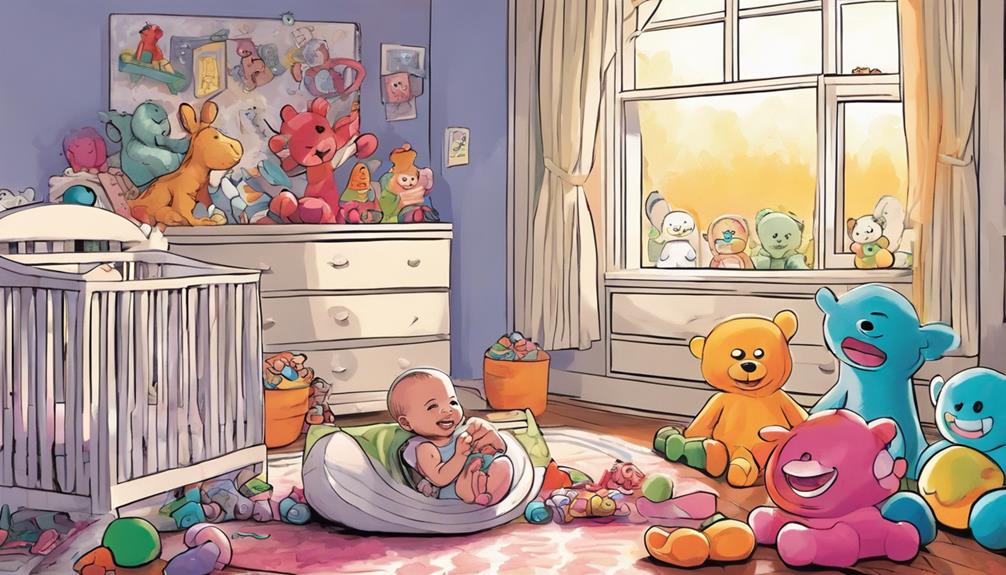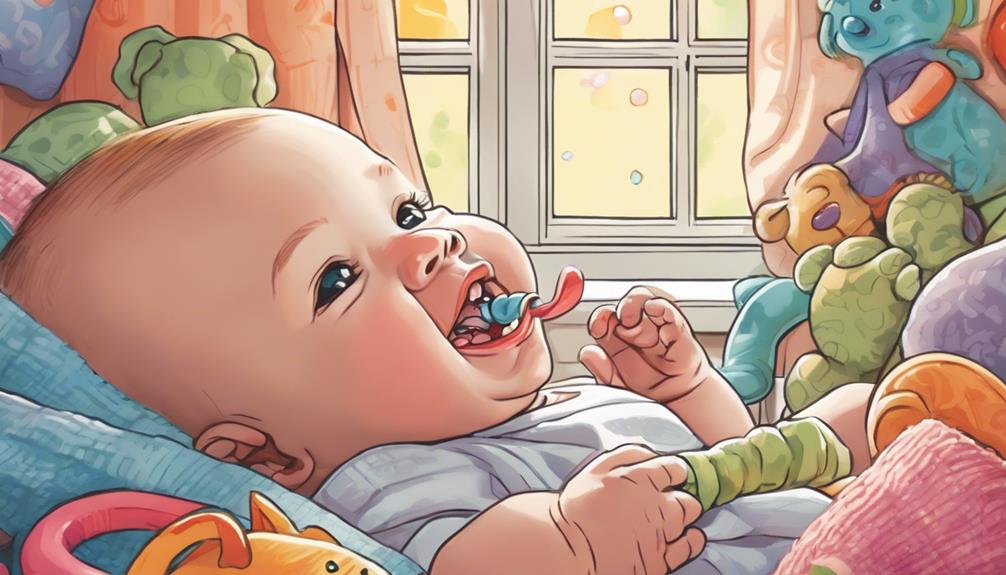Teething for babies typically begins between 4 to 7 months. You can expect those first teeth to surface around 6 months, often starting with the lower central incisors. After that, the upper central incisors usually come in between 8 to 12 months. However, every child is different—some may start teething as early as 3 months or as late as 12 months. As a parent, it's helpful to watch for signs like increased drooling and fussiness. There's plenty more to discover about the teething timeline and ways to ease your baby's discomfort, so stay tuned for additional insights!
Key Takeaways
- Teething typically begins between 4 to 7 months, but signs can appear as early as 3 months.
- The first teeth to emerge are usually lower central incisors, around 6 to 10 months.
- Upper central incisors typically follow, appearing between 8 to 12 months.
- A complete set of 20 primary teeth is generally achieved by age 3.
Understanding Teething

Teething can be an exciting yet challenging time for you and your baby as those first little teeth begin to emerge, typically starting between 4 to 7 months of age. Most babies start teething with their lower central incisors, which usually erupt around 6 to 10 months.
You might notice various signs of teething as the first tooth erupts, including increased drooling, irritability, and even a slight fever in some cases.
Teething symptoms can differ considerably from one infant to another. While some babies breeze through the process with minimal discomfort, others may experience notable distress.
It's crucial to keep an eye on your baby's behavior during this time. They may chew on their toys or fingers more than usual, signaling that their gums are sore.
When Teething Begins

Most babies start showing signs of teething between 3 to 12 months, with many beginning around 6 months. At this age, you'll likely notice your infant's first teeth emerging, starting with the lower central incisors. These typically appear between 6 to 10 months.
It's fascinating to see how each child's timeline can differ; some infants may begin teething as early as 3 months, while others may not get their first teeth until closer to 12 months.
After the lower central incisors, the upper central incisors usually come in around 8 to 12 months. As your baby grows, the teething process continues, leading to a full set of 20 primary teeth by the age of 3.
Understanding when teething begins can help you prepare for this natural milestone in your child's development.
Signs of Teething
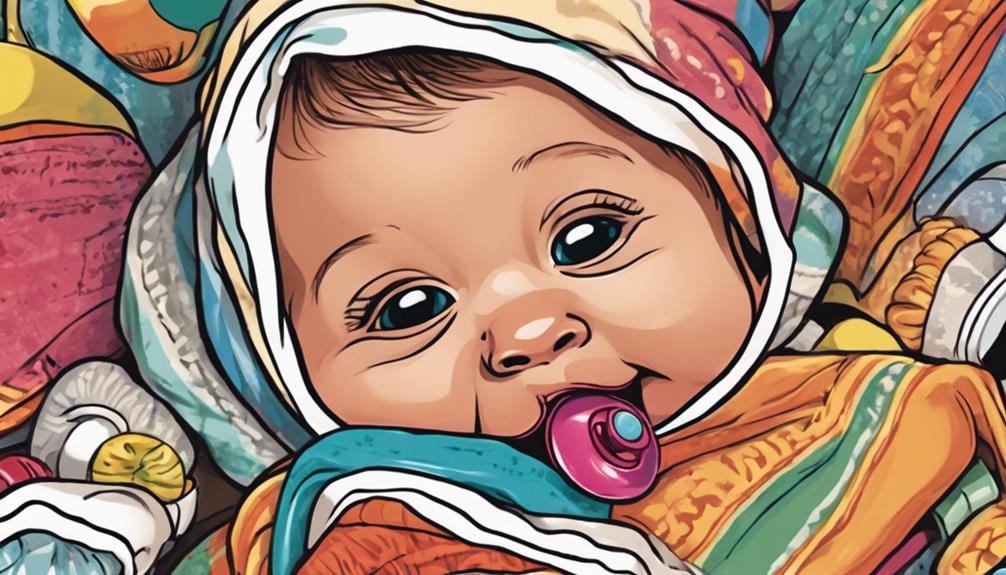
How can you tell if your baby is teething? Recognizing the signs of teething can help you understand your little one's discomfort. Here are three common signs you might notice:
- Swollen and Tender Gums: Your baby's gums may appear red and swollen as teeth start to erupt.
- Irritability: Increased fussiness and irritability can signal that your baby is experiencing teething pain.
- Flushed Cheeks: You might notice one or both of your baby's cheeks looking flushed, which can indicate discomfort.
Along with these signs, you may observe increased drooling and a desire to chew on objects.
It's also common for babies to have mild temperature elevations, but keep an eye out for high fevers or diarrhea, as these often point to other health issues.
Changes in eating and sleeping patterns can occur, too, with some babies becoming more restless or losing their appetite.
If you suspect your baby is teething, you might consider using teething gels to help soothe their discomfort.
Understanding these signs can guide you in providing the comfort your baby needs during this challenging time.
Easing Teething Discomfort

When your baby is teething, finding ways to ease their discomfort is essential.
You can try gentle gum massages, cold relief techniques like chilled teething rings, or safe chewing options like teething biscuits.
Let's explore these methods to help your little one feel better during this challenging time.
Safe Chewing Options
Choosing safe chewing options can greatly ease your baby's teething discomfort. When your little one is teething, their sore gums need gentle relief, and the right chewing products can make a difference. Here are three safe chewing options to evaluate:
- Solid Rubber Teething Rings: These are designed specifically for chewing and are free from harmful materials. Your baby can gnaw on them without worry.
- Chilled Washcloth: A clean, damp washcloth, chilled in the refrigerator, provides a soft surface for your baby to chew on, soothing their sore gums effectively.
- Teething Biscuits: While these can be a tasty option, make sure to monitor your baby closely to prevent choking. Choose biscuits without added sugars for a healthier option.
While teething products like amber necklaces may seem appealing, it's best to avoid them due to strangulation and choking risks.
Stick to the safe chewing options mentioned above to help your baby navigate the teething process comfortably. With the right choices, you can support your baby through this challenging time.
Cold Relief Techniques
Cold relief techniques can provide much-needed comfort during your baby's teething phase, helping to soothe sore gums effectively.
One of the simplest methods is using chilled teething rings. Make certain they're solid and not filled with liquid to prevent breakage. These rings can offer cold relief and a satisfying texture for your little one to chew on.
Another effective option is a frozen washcloth. Just wet a clean washcloth and place it in the freezer for a short time. Your baby can gnaw on it, enjoying the cold sensation while also benefiting from its texture to soothe their gums. However, avoid using frozen teething toys that are too hard, as they might cause discomfort or even harm to tender gums.
Remember to apply cold items for only 10-15 minutes at a time to prevent frostbite on the gums. Always consult with your pediatrician before using any pain relief medications to ascertain they're suitable for your baby's age and symptoms.
With these cold relief techniques, you can help ease the discomfort of teething and keep your baby more comfortable during this challenging time.
Gentle Gum Massage
Gently massaging your baby's gums with a clean finger can provide immediate relief from teething discomfort. This simple technique applies pressure to the swollen areas, helping to soothe your little one. You might find that doing this before bedtime can ease irritability and promote better sleep, which is often disrupted during this challenging phase.
Here are three steps to effectively massage your baby's gums:
- Wash Your Hands: Always start by ensuring your fingers are clean to avoid introducing bacteria.
- Apply Gentle Pressure: Use your clean finger to massage your baby's gums in a circular motion, focusing on the areas where teeth are emerging.
- Combine with a Chilled Teething Ring: For added relief, consider using a chilled teething ring alongside your massage to numb the area and reduce swelling.
Regular gum massages not only provide immediate relief from teething discomfort but also help your baby get used to dental care. This can make the shift to brushing their teeth much easier as they grow.
Dental Care for Infants
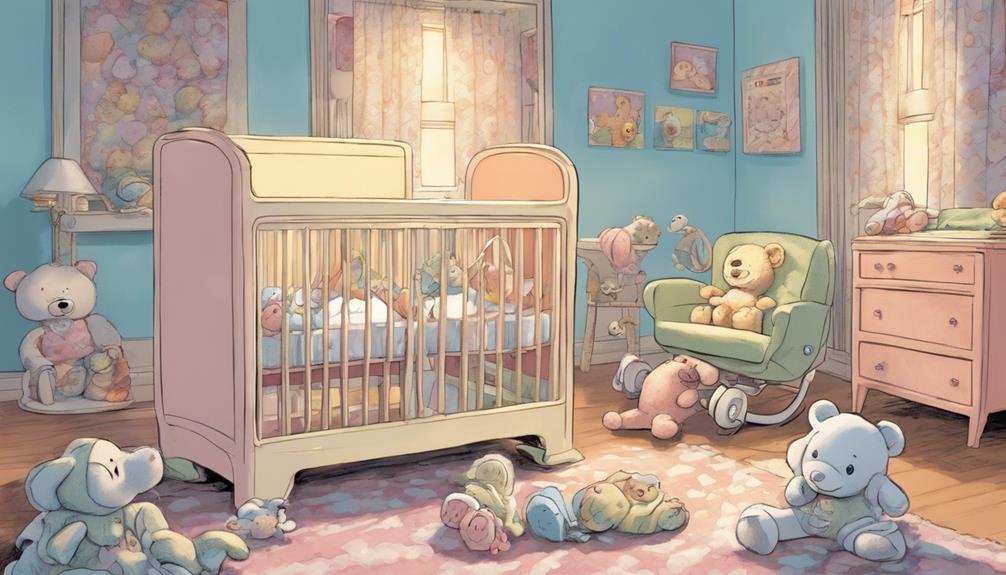
Establishing a dental hygiene routine early on is essential for your infant's oral health, even before their first tooth emerges. Begin by cleaning your baby's gums with a soft cloth or gauze. Once that first baby tooth appears, start brushing with a soft-bristled toothbrush and a smear of fluoride toothpaste. This promotes healthy teeth development.
It's important to incorporate flossing when two teeth touch, as this helps remove plaque and food particles. Regular dental check-ups should begin by age 1 or when the first tooth appears, allowing you to monitor your child's dental health and development. Additionally, encourage healthy eating habits, steering clear of sugary foods that can lead to cavities as your child shifts to solids.
Here's a quick reference table to help you remember key milestones in infant dental care:
| Age/Development Stage | Action Required | Importance |
|---|---|---|
| Birth to 6 months | Clean gums with cloth | Establish dental hygiene |
| 6 months | First tooth appears; start brushing | Promote healthy teeth development |
| 12 months | First dental check-up | Monitor oral health |
| 12-24 months | Begin flossing when teeth touch | Prevent plaque buildup |
| Ongoing | Maintain healthy eating habits | Support overall dental health |
Teething Timeline Overview
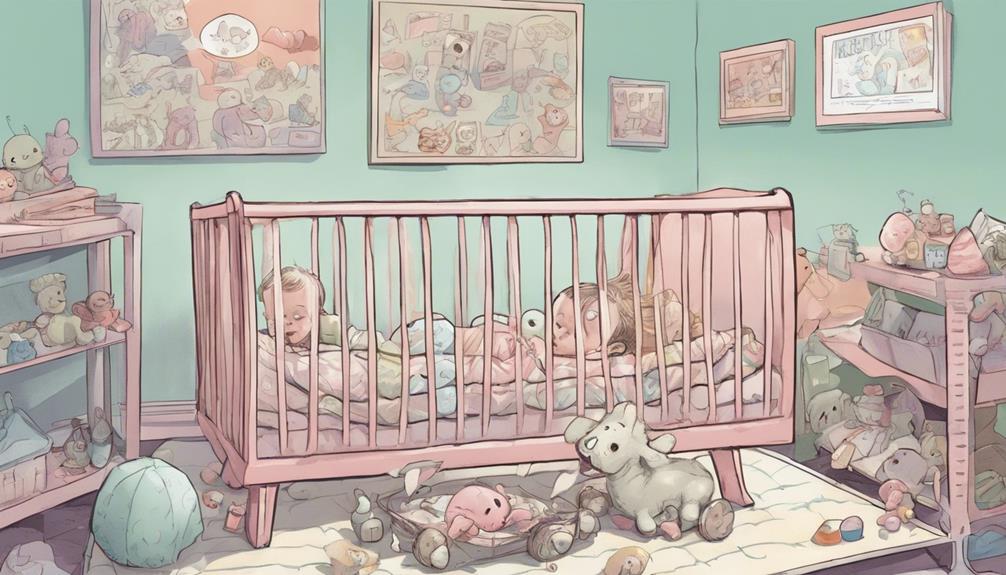
When it comes to your baby's teething timeline, you can expect their first teeth to start coming in around 6 months, although some may surprise you by starting earlier or later. The bottom two middle teeth, known as the bottom central incisors, are usually the first to appear. After that, the rest of their 20 primary teeth will gradually come in over the next 2-3 years. This baby teething timeline can be a challenging time for both babies and parents, as the discomfort and irritability associated with teething can vary from child to child. It’s important to offer your baby plenty of comfort and soothing methods during this period to help alleviate their discomfort.
The typical order of eruption usually follows a pattern, but remember, each child is unique and may not stick to this schedule.
Understanding these factors can help you navigate this milestone more easily.
Typical Eruption Ages
Typically, babies start teething around 6 months old, although some might begin as early as 3 months or as late as 12 months. The timeline for tooth eruption is essential for parents to understand.
The first teeth to appear are usually the lower central incisors, which come in between 6 to 10 months. After that, you can expect the following:
- Upper central incisors: Erupt around 8 to 12 months.
- Lateral incisors: Show up between 9 to 13 months.
- First molars: These larger teeth appear from 13 to 19 months.
Individual Variation Factors
Not every baby follows the same teething timeline, and various factors can influence when your little one will start to sprout those first teeth. Teething typically begins between 3 to 12 months of age, with most infants starting around 6 months. However, you'll notice individual variation; some babies may show their first teeth as early as 3 months, while others mightn't have any by their first birthday.
Interestingly, baby girls often start teething just a bit earlier than baby boys, but this difference is generally minor. The first teeth to erupt are usually the lower central incisors, which typically make an appearance between 6 to 10 months of age.
You may observe that teething patterns differ considerably among infants. Some children experience a lengthy teething process, with teeth emerging slowly over time, while others have a rapid eruption of teeth.
Understanding these individual variations can help you navigate your baby's teething journey with more ease. Keep an eye on the signs, and remember that each child is unique in their teething age and patterns.
Common Teething Myths
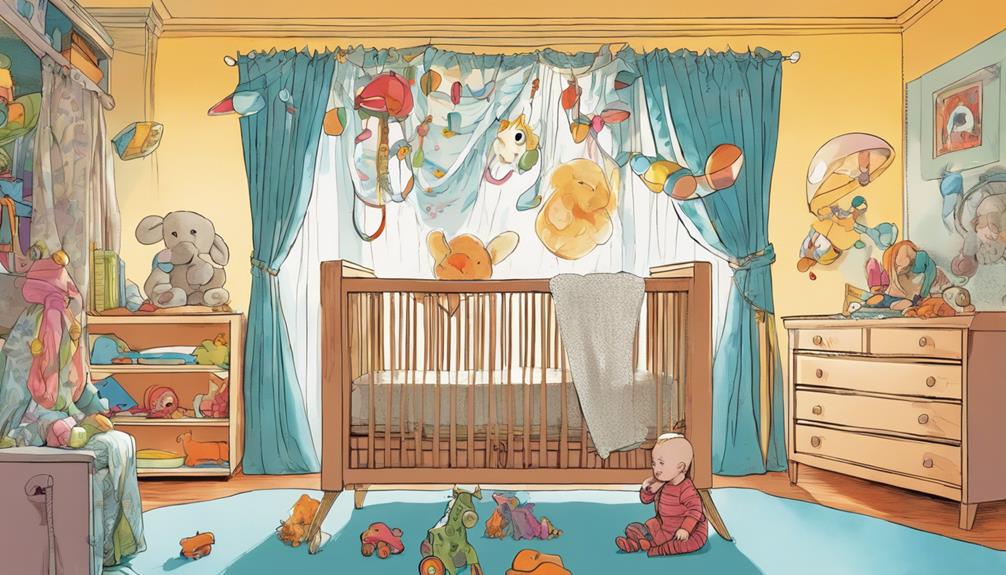
Many parents believe common myths about teething that can lead to unnecessary worry and confusion. It's important to separate fact from fiction. Here are three myths you might encounter:
- Teething causes diarrhea: There's no scientific evidence linking teething to gastrointestinal symptoms. If your baby has diarrhea, it might be due to something else.
- Teething results in high fever: Many think teething always causes a high fever. In reality, teething may only lead to a mild temperature increase (less than 100.4°F or 38°C). A higher fever usually indicates an illness, not teething.
- Severe discomfort is guaranteed: Some parents assume that all babies experience severe discomfort during teething, but that's not true. Many infants handle the process with little to no noticeable symptoms.
Also, avoid using teething gels containing benzocaine for babies under two years, as they're not recommended due to safety concerns.
If your baby develops rashes during teething, consult a healthcare professional to rule out other causes. Understanding these myths can help you feel more at ease during this developmental phase.
Order of Tooth Eruption
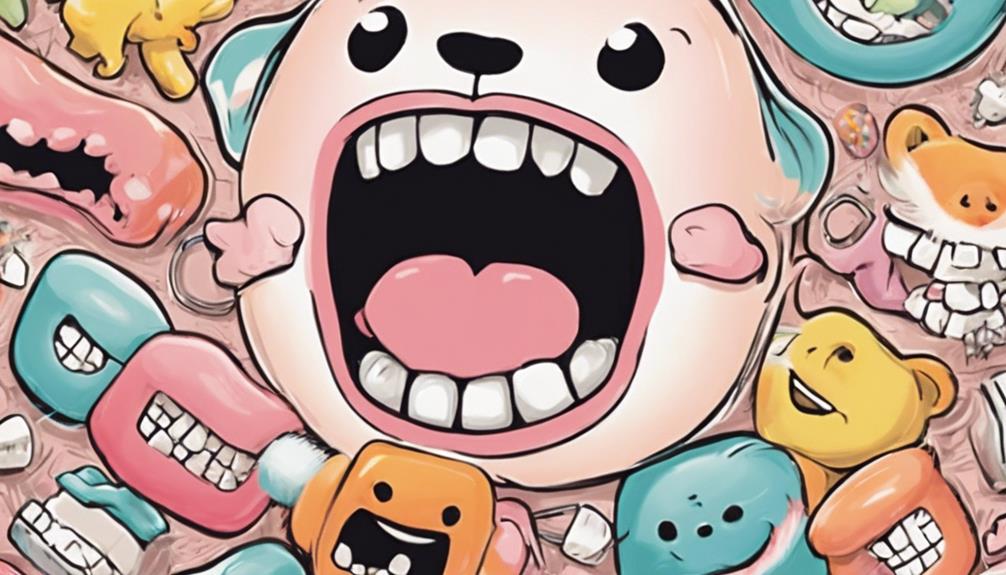
When it comes to the order of tooth eruption, you'll notice a typical sequence that most babies follow. While there's some variability in timing among infants, understanding this pattern can help you anticipate when each tooth is likely to emerge.
The primary teeth play an essential role in your baby's development, setting the stage for their future dental health.
Typical Eruption Sequence
The typical eruption sequence of baby teeth begins with the lower central incisors, usually emerging between 6 to 10 months of age. As your baby grows, you'll notice the arrival of more teeth in a specific order, helping to shape their adorable smile.
Here's what to expect:
- Upper central incisors (8 to 12 months) – These teeth will make their appearance shortly after the lower ones, creating a balanced look.
- Lateral incisors (lower: 10 to 12 months; upper: 9 to 13 months) – These come next, filling out the smile even more.
- First molars (13 to 19 months) – These larger teeth help your little one chew as they start exploring solid foods.
As your child reaches around 3 years old, they'll have their complete primary teeth set, including the canine teeth that emerge between 16 to 22 months, and the second molars that appear last, from 25 to 33 months.
Tracking this typical eruption sequence can be an exciting journey for you and your baby, marking milestones in their development!
Timing Variability Among Infants
Teething can vary considerably among infants, with some starting as early as 3 months and others not until they reach 12 months. When it comes to the timing of when teeth come in, most babies begin teething around 6 months old.
The first teeth usually to appear are the lower central incisors, typically between 6-10 months. Following that, you can expect the upper central incisors around 8-12 months.
Next in line are the lateral incisors, with lower ones emerging between 10-12 months and upper ones appearing between 9-13 months. It's important to remember that not all babies follow this exact timeline. Your baby might be teething a bit earlier or later than average.
After the incisors, the first molars usually come in between 13-19 months, followed by canines at 16-22 months, and finally, the second molars erupting between 25-33 months.
Role of Primary Teeth
Understanding the order of primary teeth eruption is essential for tracking your baby's dental development and ensuring their oral health. Knowing when each tooth comes in helps you anticipate your baby's needs and manage any discomfort they may experience during the teething process.
Here's what you can expect as the primary teeth emerge:
- Lower central incisors: These usually appear first, typically between 6 to 10 months. They're often the most noticeable and can cause some gum discomfort.
- Upper central incisors: Following closely behind, these usually erupt between 8 to 12 months, adding to your baby's growing smile.
- Lateral incisors: These come in next, with lower ones appearing between 10 to 12 months and upper ones between 9 to 13 months.
As the tooth eruption continues, you'll see first molars between 13 to 19 months, canines around 16 to 22 months, and finally, the second molars between 25 to 33 months.
Safe Teething Remedies

For soothing sore gums during teething, parents can rely on safe remedies like chilled, BPA-free teething rings and cold washcloths. These options are effective in relieving teething discomfort without the risks associated with some other methods. Cold washcloths can be given to your little one for chewing, providing a gentle and safe way to ease their discomfort.
When choosing teething toys, always opt for ones specifically designed for this purpose. It's essential to supervise infants while they use these toys to prevent any choking hazards. Avoid teething gels that contain benzocaine for children under 2 years old, as they can pose health risks.
If you're considering natural remedies, such as chamomile tea, it's a good idea to consult a pediatrician first. They can guide you on which remedies are safe and suitable for your baby. Remember, every child is different, so what works for one mightn't work for another.
First Dental Appointment

Scheduling your baby's first dental appointment after their first tooth comes in or by their first birthday is an important step in safeguarding their oral health. This visit is vital for establishing a strong foundation for your little one's dental care. Pediatric dentists specialize in the needs of infants and toddlers, focusing on normal development and preventive care.
During the first dental appointment, expect the following:
- Dental Check-Up: The dentist will examine your baby's first tooth and assess overall oral health.
- Guidance on Oral Hygiene Practices: You'll receive tailored advice on how to care for your baby's teeth as they begin to emerge.
- Establishing a Dental Home: Creating a relationship with a pediatric dentist guarantees ongoing support and monitoring of your child's dental development.
Regular visits every six months or as advised by the dentist will help maintain ideal oral health. By prioritizing this first dental appointment, you're setting the stage for healthy habits that will last a lifetime.
Make certain to ask questions and engage with the dentist to make sure you're well-equipped to care for your baby's growing smile!
Frequently Asked Questions
When Should I Expect My Baby Teeth?
You can expect your baby's teeth to start coming in around six months. The first to appear are usually the lower front teeth, followed by the upper ones, but every baby is unique in timing.
What Is the Timeline of Baby Teeth Coming In?
The timeline for baby teeth usually starts around 6 months. You'll likely see lower central incisors first, followed by upper ones. By age 3, your child should have all 20 primary teeth.
What Age Do Babies Start Forming Teeth?
Imagine your baby's smile shining like a new smartphone! Teeth actually start forming in the womb, but they typically begin to emerge around 6 months, with the first ones usually being the lower central incisors.
When Should I Start My Baby Teeth?
You should start checking for your baby's teeth around 4 to 7 months. Watch for signs of teething, like drooling or fussiness, and consult your pediatrician if you have any concerns about their development.
At What Age Do Babies Typically Start Growing Teeth?
Babies typically start the teeth eruption timeline in babies around six months old, although it can vary. Some may start as early as three months, while others may not start until their first birthday. It’s important to monitor their growth and consult a pediatrician for any concerns.
Conclusion
In summary, steering through your baby's teething journey can feel tricky, but you're not alone.
By recognizing the signs, providing soothing solutions, and staying informed, you'll help your little one shine through this stressful stage.
Remember, regular dental check-ups are key to keeping those tiny teeth healthy.
Embrace the experience with empathy and enthusiasm, and soon, your baby will proudly flaunt a fabulous first smile that sparkles with every giggle.
Happy teething!
